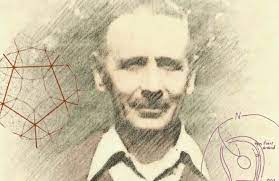Christos Papakyriakopoulos was born in Athens on the year of 1914 and was one of two children of a wealthy Athenian family.
He attended classes at the Varvakeios High School, where his inclination for the study of the field of mathematics was shown.

In 1933, according to his father’s wishes, he was admitted to the National Technical University of Athens (NTUA) at the department of Civil Engineering, a decision which was well received by the latter as he wished his son to not become a “common teacher”. There Kritikos, a mathematician (whose one of the fields of expertise was topology and more specifically the Jordan Arc and had prior met Konstantinos Karatheodoris at the city of Monaco), noticed his mathematical capabilities and urged him to drop out of the NTUA and attend classes at the Department of Mathematics of the University of Athens.
Upon being admitted to the Department of Mathematics, he studied hard for the most part alone and soon enough his interest was piqued with this new mathematical field called topology (Topology is closely resembling geometry, with the difference that it devotes its attention to the qualitative description of an its object not so much at the quantitative).
In 1937 at a time when Karatheodoris happened to be in Athens, Kritikos encouraged Papakyriakopoulos to send him his work on the closed Jordan Arcs, which Karatheodoris profoundly appraised in a letter that followed, characterizing it as incredibly elegant.

In 1938 he completed his graduate studies and went on to complete his PhD. It was then however that he was summoned to take part in the Second World War at the Albanian Frontier. In one of his letters sent by him to Kritikos, he begs him in case he doesn’t return from the war, to have his doctoral diatribe published for him.
After countless hardships in 1943, Papakyriakopoulos published his diatribe in which apologized to his readers for any spelling mistakes, as he tried his best to avoid them but due to not having the chance to thoroughly revise it, the economical inflation that followed causing continuous revaluation of paper prices and the war conflict that also posed a threat to his own life, it was proved impossible.
After the occupation of Greece by Axis Powers, he returned as the assistant of Kritikos at the NTUA from which after a while both were fired because of their political ideas.
He was an active member of the left-wing political party and the communist movement, assisting at the distribution of messages and the protection of wanted.
After the events of Dekemvriana in 1944, he fled to the mountains with the rebels of the National Liberation Front (NFL).
He taught arithmetic at an elementary school in a village close to the city of Karditsa. At the same time his uncle, who was at the time the Minister of Internal Affairs, was searching for him to appoint him to the position of mayor to the city of Chalandri, but his attempts proved futile. Roundabout the same time he lost his brother who was fighting against the Germans as a member of the 3rd Greek Mountain Brigade (known as Rimini Brigade) at the north part of Italy.
Somewhen in the year of 1947 he wrote a letter to Fox of Princeton University, which included his mathematical proof of the lemma of Dehn, that included a mistake which was pointed out by Fox. However, Fox discerned his incredible mathematical abilities and recommended him to come and work as a researcher at Princeton.
In 1950 when he left Greece, his mother displayed symptoms of cancer and passed away soon after.
In 1951 he returned to Greece and after making his will, in which he transfers most his dower to the NTUA (the Papakyriakopoulos bequest that stands to this day and is funding the scholarships of the most academically successful postgraduate and doctoral students).
After his return, he devoted a great deal of his time at his studies and soon after he managed to provide the mathematical proof for the lemma of Dehn (with no mistakes this time) and the theorem of spheres, both of which are fundamental to the low dimensional topology.
Following his success, he received the expected recognition, as in the year of 1964 he was awarded the Veblen award of geometry.
Papakyriakopoulos was turned into a legend at the Princeton University, while Christos Papadimitriou describes him as a quiet, distant and kind figure.
The last years of his life were spend to the mathematical proof of the Poincaré conjecture, a decision of a lifetime.
He may had not been the one to find the proof to the Poincaré conjecture, but as it is with many other stories of mathematicians, his long-term research laid the foundations to the finalized mathematical proof of the conjecture.
Christos Papakyriakopoulos was one of the founders of the modern tree-dimensional topology and blazed the trail for the field’s evolution.
Translated by : Menoudea Theodora
Proof read by : Zoi Filiou
